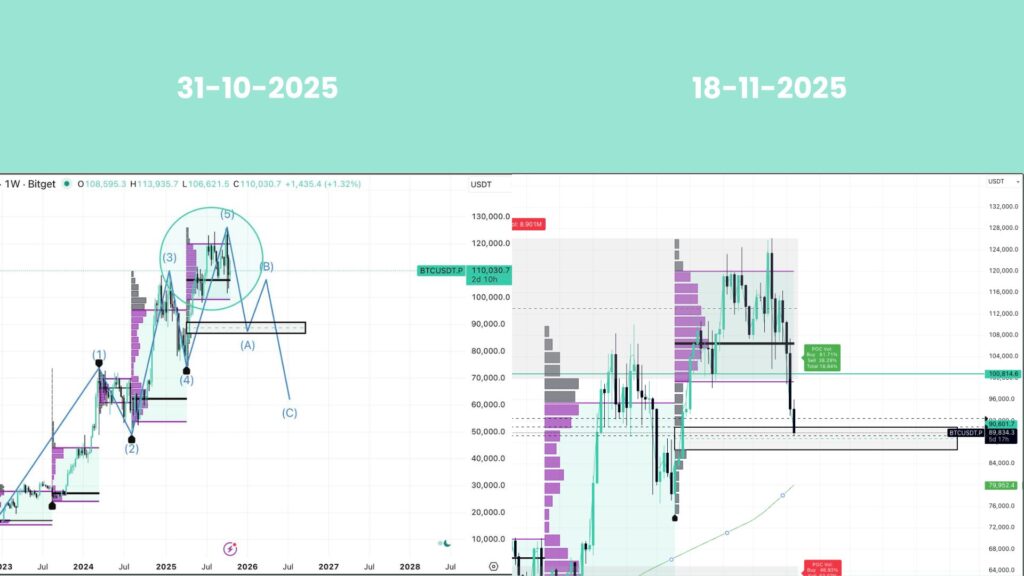The crypto market has been constantly moving, growing to over $4 trillion in market valuation, while subsequently losing over 30% of its peak valuation. Bitcoin has fallen 27% from its all-time high of $126,000, and Ethereum and other digital assets have followed suit.
With the Fear and Greed index firmly rooted in “extreme fear” for over a month and institutional ETF inflows repositioning as outflows registered $523.2 billion in a single day, many investors are analyzing the market position in 2025 or preparing for a prolonged market correction.
What’s driving the market decline
A few interconnected factors are driving the current market sentiment, which has seen Bitcoin unable to recover since its record $19 billion liquidation. At Yieldfund, we first highlighted Bitcoin’s corrective structures in an earlier post, identified demand and volume zones, and emphasized the potential end of the long-term bullish structure.

Profit-taking and thinning order books
Demand for Bitcoin at a premium is shrinking. ETF inflows haven’t fully recovered since the October 19th liquidation events, as large wallets have been seen offloading while smaller wallets have continued to accumulate. According to the head of market insights at Hashdex Asset Management, selling pressure has been a major contributor to Bitcoin’s current struggles. Primarily because demand for Bitcoin has decreased since market makers took a big hit, leading to fewer buy and sell orders remaining on the market.
Macroeconomic uncertainty
A second, indirect effect that led investors to seek less risk-averse investments was the broader economic climate. Bitcoin has always been closely tied to macroeconomic events, including the stock market.
While the Trump administration has increased pressure on the Fed to lower interest rates, the effects have been less effective. Most of the rate cuts have been priced in, with stocks and crypto rarely posting significant post-announcement gains.
Additionally, there’s growing concern about a potential AI bubble. A recent Bank of America survey found that 45% of fund managers believe an AI bubble is the biggest tail risk to the market. Even though the consensus is that we might be in an AI bubble, which could drive the tech stock sector down—along with crypto —many believe the bubble people are worrying about is not as severe as they imply. Bill Ford emphasized that the lack of a bubble stems from strategic investments by S&P 500 companies rather than retail hype.
Institutional outflows
A potential bearish signal that has most investors worried is the high institutional ETF outflows. Data shows that most institutions acquired Bitcoin at prices between $60,000 and $72,000, with only MicroStrategy having a lower DCA price of $72,000. BlackRock’s iShares Bitcoin Trust (IBIT), a major player, shed a record $523 million in a single day, part of a five-day streak of outflows. This indicates that institutional sentiment, a key driver of recent market stability and growth, is temporarily diminishing. While it’s yet unknown how and when Bitcoin will correct, institutions are preparing for it.
Are there any bright spots?
Despite the market downturn, not every asset is in the red; some have seen their valuations increase amid Bitcoin’s slump. The performance of certain altcoins suggests a more nuanced market than a simple “risk-off” environment.
Zcash (ZEC), a privacy token, has shown resilience, gaining 31% over the past week and posting more than 200% over the past month. Analysts emphasize that as Bitcoin becomes a more mainstream asset susceptible to institutional manipulation, new crypto narratives are shifting toward privacy-focused coins like Zcash, which are harder to track on the blockchain.
Expert predictions for 2025
Analysts are divided on what comes next. The technical indicators are not encouraging. Bitcoin’s chart recently formed a “death cross”—where its 50-day moving average crosses below the 200-day average—a pattern that often signals longer-term bearish momentum. Arthur Azizov, founder of B2 Ventures, is closely watching the $89,000–$94,000 zone, noting a worst-case scenario could see a return to the $72,000–$74,000 range seen in April 2025.
However, some experts see this as a healthy correction. Arthur Hayes, a founder of the BitMex exchange, believes the slump is due to a temporary liquidity crunch and predicts Bitcoin could surge back to over $200,000 if U.S. dollar liquidity conditions change. Similarly, Ryan Rasmussen, head of research at Bitwise, views the current market as “the perfect opportunity for investors to build on existing bitcoin positions.” While both outlooks are possible, it’s impossible to predict exactly how Bitcoin and the crypto market will react in the remainder of 2025.
A balanced outlook for the future
The crypto market is at a critical juncture. A combination of profit-taking, macroeconomic fears, and waning institutional inflows fuels the current downturn. While technical indicators point to potential further losses, the industry’s optimistic long-term forecast suggests it may be a temporary setback.
However, Bitcoin runs in cycles, and following the halving cycles, Bitcoin’s top, as emphasized by analysts, points to September or October of 2025. This signals a potential shift in a broader downtrend, which, from the point of view of some investors, is a healthy correction that will help fuel the next cycle.


